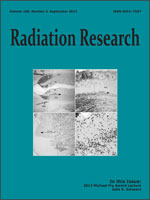After the Tokyo Electric Power Company Fukushima Daiichi nuclear power plant accident on March 11, 2011, the reconstruction of early internal radiation doses in residents of Fukushima plays a major role in evaluating their future heath risk, including thyroid cancer by internal radioiodine. Internal radioactivity was measured using a whole body counter (WBC) at the Nagasaki University Medical School to evaluate the health risks of residents and short term visitors in Fukushima. Measurable 131I, 134Cs and 137Cs were detected altogether in 49 out of 196 people who were in Fukushima prefecture at any time during March 11 and April 20, 2011. In 49 people, the 90 percentile of the thyroid equivalent dose by 131I and the committed effective dose (total effective dose over a lifetime) by the sum of 134Cs and 137Cs was 3 mSv and 0.06 mSv, respectively. The radionuclide intakes in early evacuees who left Fukushima before March 16 were more than five times as high as in the responders who moved to Fukushima later. The intake ratio of 131I/137Cs of the earlier evacuees was approximately three. The spatial analysis of 16 evacuees to the south indicated a reduction of internal radioactivity depending on the distance from the nuclear power plant. Among them, high internal 131I radioactivity in 6 people in a particular evacuation route could be explained by the arrival of a radioactive cloud with a high airborne 131I/137Cs ratio to the environment, as predicted by atmospheric dispersion simulations. Overall, the actual internal radioactivity assessed by a WBC examination comparatively agreed with the predicted airborne radioactivity. These results suggest that the accurate estimation of internal doses in the first week after the radiological accident is critical for the dose reconstruction. The evaluation of internal doses of residents based on their evacuation routes and the advanced estimation of airborne radioactivity from the atmospheric dispersion model should continue to be assessed.
How to translate text using browser tools
16 August 2013
Spatiotemporal Characteristics of Internal Radiation Exposure In Evacuees and First Responders after the Radiological Accident in Fukushima
Naoko Morita,
Miwa Miura,
Masahiro Yoshida,
Atsushi Kumagai,
Akira Ohtsuru,
Toshiro Usa,
Takashi Kudo,
Noboru Takamura,
Shunichi Yamashita,
Naoki Matsuda
ACCESS THE FULL ARTICLE

Radiation Research
Vol. 180 • No. 3
September 2013
Vol. 180 • No. 3
September 2013




